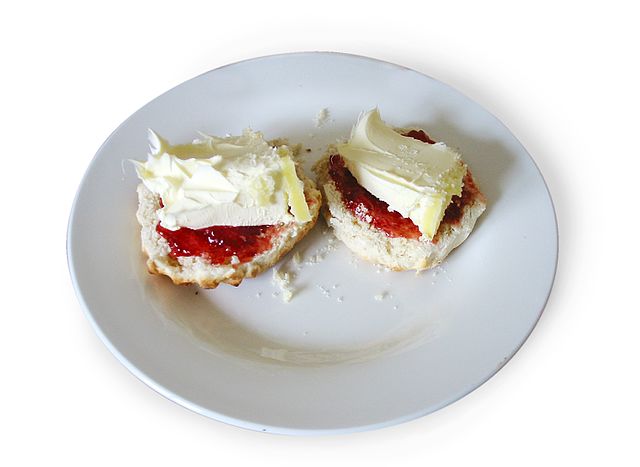Top Qs
Timeline
Chat
Perspective
Cream tea
English afternoon snack From Wikipedia, the free encyclopedia
Remove ads
A cream tea (also known as a Devon cream tea, Devonshire tea,[1] or Cornish cream tea)[2] is an afternoon tea consisting of tea, scones, clotted cream (or, less authentically, whipped cream), jam, and sometimes butter. Cream teas are sold in tea rooms throughout England, especially Devon and Cornwall, and in some other parts of the Commonwealth.


Remove ads
History
The origin of the cream tea is disputed, although there is evidence to suggest that the tradition of eating bread with cream and jam existed at Tavistock Abbey in Devon in the 11th century.[3] The Oxford English Dictionary reports the earliest use of "cream tea" in the sense of the afternoon tea, as opposed to a cup of tea with cream in it, is in the 1964 novel Picture of Millie by Philip Maitland Hubbard, "We just bathe and moon about and eat cream teas." However, the "Foods of England" website has discovered an earlier newspaper cutting, The Cornishman of Thursday, 3 September 1931 (p. 8), which uses the phrase in what appears to be its modern sense: "For an alleged Cornish cream tea consisting of three slices of bread and butter, a splashing of cream and jam and two anemic rolls, I was charged 1s. 6d."[4]
Remove ads
Variations
Summarize
Perspective
There are regional variations as to how a cream tea should preferably be eaten.
- The Devonian, or Devonshire, method is to split the scone in two, cover each half with clotted cream, and then add strawberry jam on top. The Devon method is also commonly used in neighbouring counties.
- With the Cornish method, the warm 'split' or a 'scone' is first split in two, then spread with strawberry jam, and finally topped with a spoonful of clotted cream. This method is also used elsewhere, notably in London.[5]
Although these distinctions on whether to apply the jam or the clotted cream to the scone first are still claimed by many, cream teas are served and enjoyed both cream first and jam first throughout both counties.
Scones are rarely buttered in commercially available teas. Traditionally it is important that the scones be warm (ideally, freshly baked), and that clotted (rather than whipped) cream and strawberry jam, rather than any other variety, be used. Butter is generally not included, and some sources advise that the tea should not be served with milk.[6]
In Cornwall an alternative was traditionally a "split", a type of slightly sweet white bread roll, rather than a scone.[7] It is now rare to find this available commercially, even in Cornwall, but splits are still used by many Cornish families in their own homes.[8] In Devon, an alternative to the scone found occasionally is the "Devon split" or "Chudleigh", lighter than a scone and smaller than a Cornish split.[9]
Another variation to a cream tea is called "Thunder and Lightning", which consists of a round of bread or a Cornish split, topped with clotted cream and honey or golden syrup.[2]
Yet another variation is a "savoury cream tea", with cheese scones; cream cheese instead of clotted cream, and chutney instead of jam.[10]
Remove ads
Protected status
In May 2010, a campaign was launched at the Devon County Show to have the name "Devon cream tea" protected within the European Union under Protected Designation of Origin (PDO) rules. The campaign was launched following discussion on BBC Radio Devon.[11]
See also
References
Further reading
Wikiwand - on
Seamless Wikipedia browsing. On steroids.
Remove ads

